Clips, terminals and other ways of connecting wires
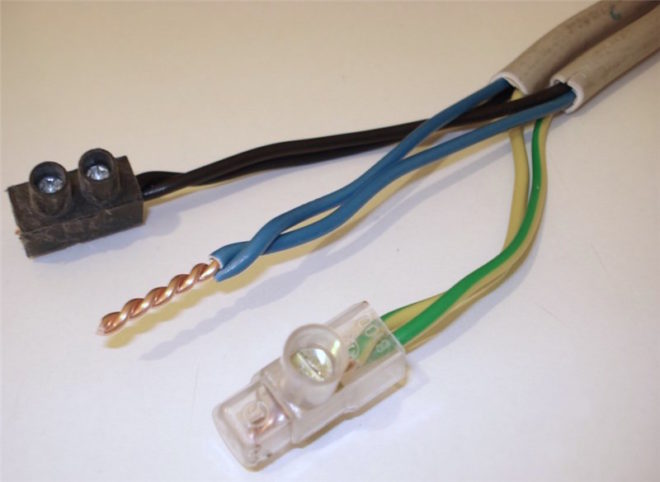
Those who are independently engaged in the repair of home electrical wiring constantly have to deal with such a concept as connecting wires. There are many ways to do this - from the ancient old-fashioned method of twisting to modern terminal blocks. Regardless of what exactly you are doing now - overhaul of the household electrical network or connecting a new element (switch, lamp or socket), the connection must always be reliable. The safety of your home directly depends on this. Let's talk about what is still stronger and more profitable - use clamps for wires or twist them and solder them?
Content
Twisting does not go out of fashion
The modern market in such a variety presents terminals for connecting electrical wires that it would seem that it is high time to forget about twists. But this method continues to be popular with electricians, despite the fact that factory connectors provide safety and reliability. In addition, the terminals are much more convenient to use and look more aesthetically pleasing than twisted wires rewound with electrical tape.
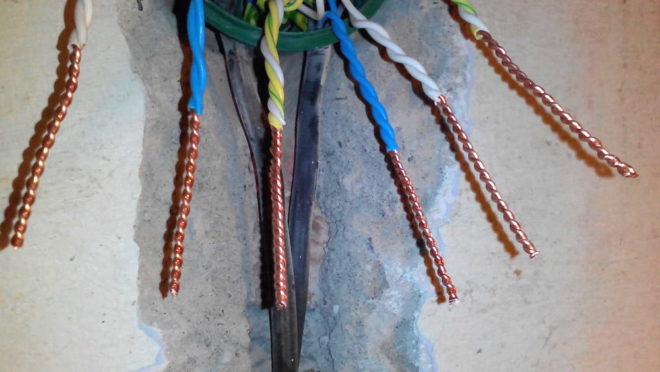
Twisting has one more very important drawback. If we consider this method objectively, it does not fit any concept - detachable or non-detachable. Logically, it is clear that the split ends can be repeatedly separated. But twisting cannot be called a full-fledged detachable connection, because each time after untwisting and re-twisting, the ends of the wires will deteriorate. Twisting also does not fit under the concept of a one-piece connection, because it does not have the necessary stability, strength and reliability.
How to make a good twist is described in this video:
But if you do not get rid of twisting the conductors of the wires, then at least use convenient and safe connection caps instead of an insulating tape.
PPE caps
Caps are also called connecting insulating clamps (abbreviated PPE).
Structural performance
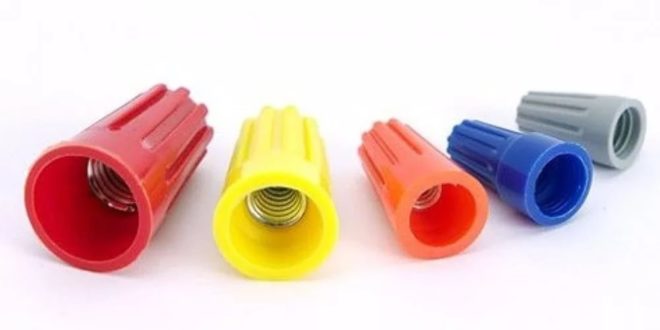
Outside, the cap body is made of plastic. This material has a number of positive aspects:
- does not support the combustion process under the influence of open fire;
- capable of withstanding operating voltage up to 600 V;
- has good insulating properties.
The plastic case, in addition to insulating the junction, also protects it from mechanical damage.
Inside the cap is equipped with a crimping spring made of steel and in the shape of a cone. When the wire twist is inserted into the cap, the coils of this spring are additionally compressed.
When using caps, it is very important to properly cut the twist ends. The insulating layer must be cut off so that the bare metal is not outside the cap, but completely falls under the crimp spring.
Preparing wires for caps
Now in the electrical world it is already considered a mistake to expose a wire or cable from an insulating layer with a knife. Professional electricians use special tools - insulation strippers.

This fixture has calibrated holes for each standard core diameter (cutting edge at the holes). The insulation stripper does not damage the conductive surface layer, which preserves its strength.
Nobody cancels the Monter's knife either. The main thing is to position it when removing the insulation to the direction of the cut at an angle so as not to snag the metal core.The location of the knife during the removal of the insulating layer at a right angle is not allowed, since there is a high probability that you will make a circular cut, as a result of which the core can then break.
When choosing PPE caps, special attention should be paid to the size of the compression springs. The main contact is made at its smallest tapered part. It is very important that it matches the wires to be connected. If the cores are thin, the compression by the cone spring will not work out tightly, and the thick twisted cores, on the contrary, will not enter the cap to the end.
Core connection
In practice, connecting wires with PPE caps is done in two ways:
- No pre-twisting. Two conductors of the same diameter must be forcefully inserted into the spring. Then vigorously rotate the cap clockwise. In this way, twisting is made to the length of the bare metal strands of wires.
- If it is necessary to connect three or four cores, they must first be twisted with pliers, bite off the twisted end, and then put on the cap, turning it clockwise with effort.
Put on the cap with force so that due to this, the coils of the crimp spring move apart and reliably squeeze the wires to be connected.
Never use PPE caps to connect strands of different materials. To a greater extent, this applies to copper and aluminum, between which the passage of electric current causes a galvanic process.
How to make a connection with caps is shown in this video:
Types of caps
Many electricians have a negative attitude towards PPE caps. But this attitude can be due to two reasons. Either the caps were chosen incorrectly, or they were ineptly installed on the wires to be connected.
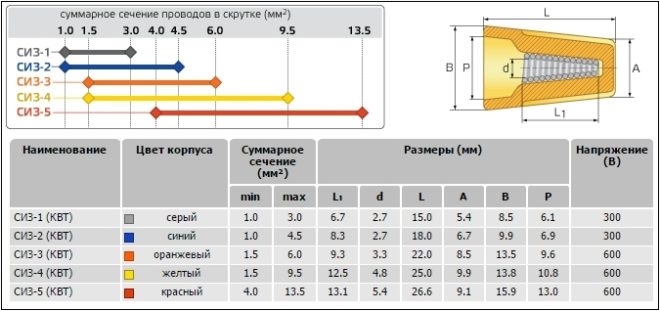
In order to correctly select the caps for the size of the wire, the manufacturers have introduced a special color marking:
- SIZ-1 - connects two conductors with a cross section of 1.5 mm2 (Gray);
- SIZ-2 - connects three conductors with a cross section of 1.5 mm2 (blue);
- SIZ-3 - connects two conductors with a cross section of 2.5 mm2 (Orange);
- SIZ-4 - connects four conductors with a cross section of 2.5 mm2 (yellow);
- SIZ-5 - connects eight cores with a cross section of 2.5 mm2 (red).
True, there are no uniform international standards for such color marking. Therefore, it may differ for manufacturers from different countries. Be careful when buying, check with the sales assistant for the required dimensions.
Terminal clamps
Terminal blocks for connecting wires give one indisputable advantage, they can connect conductors of different metals. Both here and in other articles, we have repeatedly reminded that it is forbidden to twist wires made of aluminum and copper together. The resulting galvanic vapor will lead to corrosive processes and destruction of the connection. It doesn't matter how much current flows at the junction. Late or early, the curl will still start to heat up. The way out of this situation is just the terminals.
Terminal block
The simplest and cheapest solution is polyethylene terminal blocks. They are not very expensive and are sold in every electrical store.
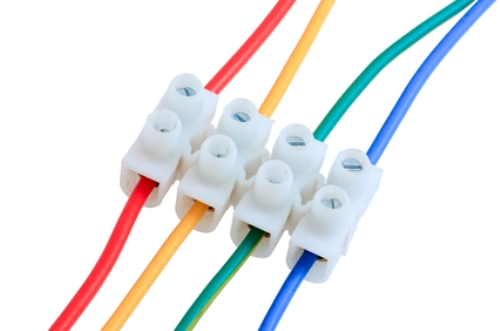
The polyethylene frame is designed for several cells, each with a brass tube (sleeve) inside. The ends of the wires to be connected must be inserted into this sleeve and tightened with two screws. It is very convenient that as many cells are cut from the block as necessary to connect pairs of wires, for example, in one junction box.
But not everything is so smooth, there are also disadvantages. In room conditions, aluminum begins to flow under screw pressure. We will have to make a periodic revision of the terminal blocks and tighten the contacts where the aluminum conductors are fixed.If you do not do this in a timely manner, the aluminum core in the terminal block will loosen, lose reliable contact, as a result, spark, heat up, which can result in a fire. With copper conductors, such problems do not arise, but it will not be superfluous to periodically audit their contacts.
Terminal blocks for connecting stranded wires are not intended. If stranded wires are clamped into such connecting terminals, then during tightening under the pressure of the screw, the thin veins can partially break, which will lead to overheating.

In the case when it becomes necessary to clamp the stranded wires into the terminal block, it is imperative to use auxiliary pin lugs. It is very important to choose the right diameter so that the wire does not jump out later. The stranded wire must be inserted into the lug, crimped with pliers and fixed in the terminal block.
As a result of all the above, the terminal block is ideal for solid copper wires. With aluminum and stranded wires, you will have to comply with a number of additional measures and requirements.
How to use the terminal blocks is shown in this video:
Terminals on plastic blocks
Another very convenient wire connector is a terminal on plastic blocks. This option differs from terminal blocks in an even metal clamp. The clamping surface has a recess for the wire, so there is no pressure on the wire from the tightening screw. Therefore, such terminals are suitable for connecting any wires in them.
Everything is extremely simple in these clamps. The ends of the wires are stripped and placed between the contact and clamping plates.
Such terminals are additionally equipped with a transparent plastic cover, which can be removed if necessary.
Self-clamping terminals
Wiring using these terminals is quick and easy.

The wire must be pushed into the hole to the very end. There it is automatically fixed by means of a clamping plate, which presses the wire against the tinned bar. Thanks to the material from which the pressure plate is made, the clamping force does not weaken and remains constant all the time.
The inner tinned bus bar is made in the form of a copper plate. Both copper and aluminum wires can be fixed in self-clamping terminals. Such terminals are disposable.
And if you want clamps for connecting reusable wires, then use terminal blocks with levers. We raised the lever and put a wire into the hole, then fixed it there by pressing it back. If necessary, the lever rises again and the wire protrudes.
Try to choose clamps from a well-established manufacturer. Clamps from “WAGO” have especially positive characteristics and reviews.».
The advantages and disadvantages are described in this video:
Scotch lock
Couplings of this type are single use. They are used for wires with low operating currents (telephone lines or wires for low power LED lamps).

Such clamping sleeves are connected by means of a displacement contact. The wires don't even need to be stripped before connecting. Directly in the insulating layer, they are inserted into tape locks and crimped with pliers. The plate, which has cutting contacts, cuts into the insulating layer, due to which there is contact between the cores.
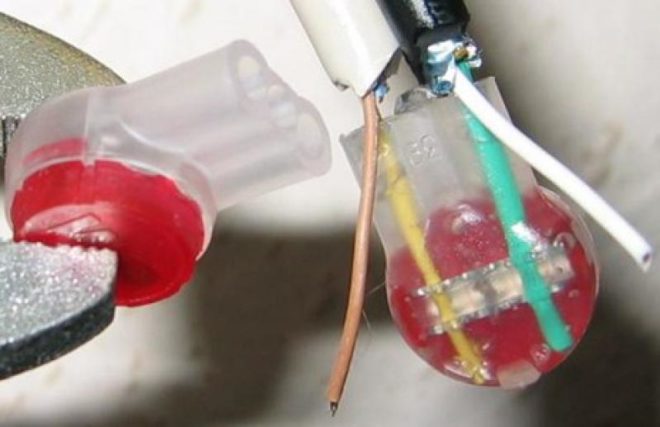
In addition to the fact that stripping of the veins is not required, scotch tape locks have a number of other advantages:
- low cost;
- versatility;
- no special devices are needed, crimping is done with ordinary pliers;
- waterproof (there is a hydrophobic gel inside the sleeve, which protects the contact connection from moisture and corrosion).
- If the scotch-lock sleeve needs to be replaced, it is simply cut out, and a new one is mounted in its place.
Liners
When powerful clamps are needed for several wires, sleeves are used. They represent a tinned copper tube, or a flat tip with a hole for fastening.
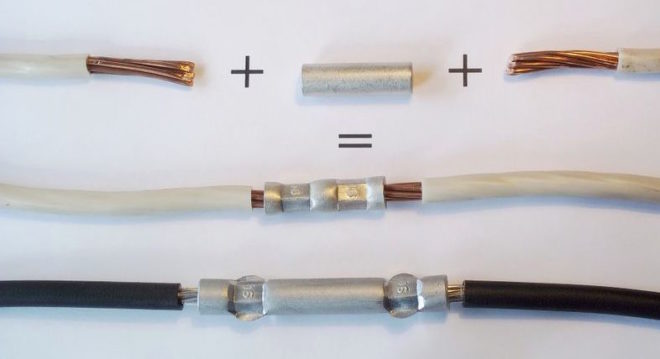
All the wires to be connected must be inserted into the sleeve and crimped using a special crimper device (crimping pliers). Such a wire clamp has a number of positive aspects:
- It is very convenient to use lugs with holes when there is a need to fasten the wire assemblies to the housings with screws.
- Crimping at the junction does not contribute to increased resistance.
As you can see, there are a lot of wire clamps, each with its own advantages and disadvantages. Choose based on which wires you need to connect, where the connection will be located. But do not forget that the most important thing in electricity is reliability and safety.




